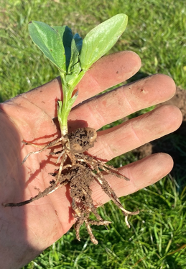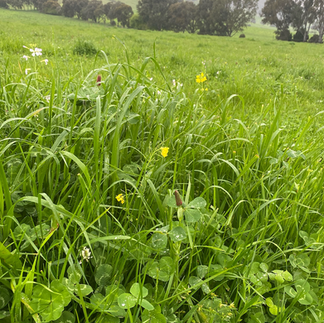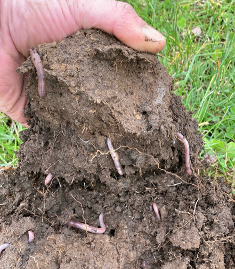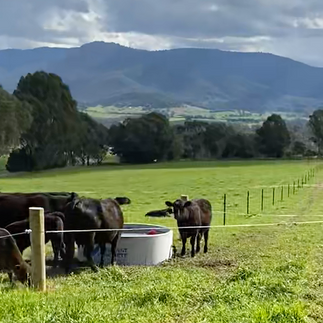Tom's Regenerative Agriculture Journey So Far - A Work in Progress
- fidgets0-kilns
- Oct 1, 2022
- 9 min read
Updated: Dec 29, 2022

Healthy Cows and Calves Enjoying Early Phase Nutritious Multi-Species Forage
The story of Tom's transitioning his 100 acre (40 hectare) beef grazing property from conventional to regenerative agriculture has been woven into the broader picture of aspects involved in regenerative agriculture set out on the main blog on this web site but for convenience this particular blog covers the major parts of his regen ag journey which started around April 2021.
Tom's property rises above the road approximately 70 metres from lowest to highest point, diagonally west to east. Cutting through the property closer to the northern side is a small watercourse that carries run-off from the steep property to the east as well as water from a spring in the vicinity of the watercourse on Tom's property (and is his principal stock water supply). Part of this area had been badly eroded many years ago but major remediation works by the previous owner had largely remedied this though there are several other areas where some minor erosion is still occurring. Most of the property comprises machine improvable slopes with soil being quite acidic. Some basic pasture improvement was in place but weeds, especially silver grass, requiring slashing / topping to try to keep it under control especially at seeding. As well as mature trees along much of the north and south boundaries, there remained a few other mature trees on the eastern end of the property. It had been fenced in four main paddocks and had one dam while stock water elsewhere was reticulated to a few troughs from the spring source.
Some fertiliser had been put out several years prior to starting his regen ag journey and hay had also been cut for several years to help with cash flow.
'Tom' (as I've called him for the purposes of this web site), for some 10 years, had been trying to follow what others in his area seemed to be doing and was taking 'advice' from agronomists and rural suppliers about what to do, however he was getting frustrated by adverse impacts, costs and use of chemicals as well as erosion risks. Per chance I sent him some information, from memory something I had received from Graeme Sait from NutriTech Solutions, which perked his interest in a different approach to farming.
Initially, and still working with his agronomist, Tom had a contractor sow part of the property to a two species pasture along with WormHit Pellets (a worm cast and compost mix) drilled in as well. The latter seems to fit well in the regen ag environment as the microbes in the worm casts come to life when moist and then have a carbon food source immediately there for their survival.
After a few months I suggested putting out some Liquid Sea Minerals on part of a paddock that was wet in what had been a wet year. About a month later as he was slashing / topping that area to try to control silver grass, he sent me a video from his tractor excitedly informing me "It's #*%-#* working mate!", that it was helping to open up the soil as he could feel from the way the tractor moved that the soil was softer. I think at this point he realised that he might be onto something.
To his credit, 'Tom' has been prepared to try various things that I have progressively exposed him to and on several occasions in the first year chose to put aside advice and recommendations from those he had previously relied upon in the conventional agriculture realm so he could continue his new regenerative agriculture journey without compromise. It has been rewarding to share his journey, hearing his excitement as soil and pastures have started to change and his amazement at the improvement in his livestock.
The first summer after Tom had applied Liquid Sea Minerals and various microbial products such as NutriSoil and more WormHit Pellets to the pastures, it was obviously having a beneficial impact on the quality of grass and cow dung, the latter attracting great numbers of dung beetles.

Dung Beetle Activity in Dung from a Healthy Cow Grazing Nutritious Pasture - (part cow pat only shown)
As Tom came to more fully appreciate the importance of what was happening below the surface, he ventured into a paddock with a shovel. He was surprised and delighted to find a few worms and see soil aggregates forming.
Early Evidence of Increased Root Mass and Improving Soil Aggregation
From the initial results that Tom has obtained with Olsson’s Australian Liquid Sea Minerals, we think it highly likely that the ionic form of calcium in it will renew the electrical charge to soil particles to overcome compaction as well as supplying the full range of minerals and trace elements to the soil. This expectation is in line with what has been achieved in America with MycorrPlus (which uses Australian Liquid Sea Minerals as its main component) and what our early experience with creating a similar ‘experimental product’ here in Australia is showing us (see below).
Because of the bulk, cost to freight and limited shelf life (due to the biological content) of the American enhanced product, it has not been a proposition to import it back to Australia, however our very early and limited ‘amateur’ trials attempting to make something similar combining various products (with Olsson’s Liquid Sea Minerals as the base) seem to be producing very encouraging results. Poorly drained soil opened up in a matter of weeks and it would seem vegetation also improved as cattle started grazing the whole paddock rather than just picking off their favourite plants. Those cattle have since been attracting high range prices at market. Those retained for breeding are now calving and the owner is reporting cows delivering easily without assistance and calves very quickly up and going, looking strong and healthy and performing amazingly well in the first few weeks like he has never seen before. It will be interesting to see the progeny of those animals when they get to breeding stage having had a mother grazing nutritious pastures and they themselves having their whole life grazing even healthier pastures as the farm continues to improve.
Tom has since stated that he has never seen heifers grow so well. After some months of grazing healthier pastures, their mother’s dung had obviously improved as evidenced by the huge numbers of dung beetles it started attracting with the surface erupting with dung beetle activity.
Another benefit that has become apparent is that heavy and extended rainfall is going into the soil rather than running off. The only ponding is along frequently used vehicle tracks / laneways and tracks frequently used by livestock. Some water did pond in one small area for a short while where a tractor had earlier been sowing a cool season diverse species forage crop, but even here there were signs of improvement with earthworm activity apparent. Elsewhere earthworm activity started to become evident in every shovel full of soil with one early dig revealing 10 worms in one shovel full without even pulling the soil apart while a more recent dig fully pulling the soil and plants apart revealed 50 worms. Soil generally is becoming spongy underfoot. Very encouraging indeed.
Early Evidence of Improving Soil - Good Root Mass and Some Rhizosphere even on Newly Germinated Seed
After the first summer, Tom again engaged the contractor again to drill in a multi-species cool season pasture along with WormHit Pellets into one paddock that had not been previously improved. A little later he was again engaged to over-sow with a cool season mix into a paddock that had previously been sown with two warm season grasses. Tom now understands the importance of diversity, not just in pasture but in microbes, each benefiting the other. Unfortunately, even though Tom was interested, the contractor was not able to organise for seed to be inoculated prior to sowing.
Diverse Pasture Doing Well in its First Spring with Natural Inputs Only - Note Size of Clover Leaves
Microbial diversity will be greatest in well mineralised soil without chemical use where a great diversity of plant types are growing as different plants attract different microbes. While some fungal diversity can be achieved by purchasing proprietary products, by far the greatest diversity will be achieved by sourcing fungal material from suitable areas on your farm and / or in your surrounding area. Using this technique some time after applying liquid sea minerals (LSM) to start restructuring soil and correcting pH, Tom found large quantities of mushrooms popping up after rain especially on and around cow dung. We were unsure at that stage if it was due to what cows have introduced or perhaps more likely due to the fungal extract falling on a very good cow dung substrate to get it going, or perhaps both these things. This initially happened towards the end of the first year of regeneration so we will continue to watch with interest. The mushrooms are the fruit of fungi in the soil and are evidence of good things happening below the surface.
Very Early Evidence of Improving Soil Biology
In another cold and wet winter and with soil armour improving, Tom decided to try out his new soil thermometer and was quite surprised to see temperatures higher than he expected. This might have helped explain why worms seemed to be still active through winter.

Soil Sampling Probe and Soil Thermometer in Action during Early Phase of Regeneration
At calving time in the second year, 'Tom' reported that the cows were all calving easily with none having to be assisted and that calves were quickly up and going. He has been amazed by how well they have grown and anticipates they will do even better than the previous lot which are now 13-14 months old. He noted that "on good feed cattle start to grow out in the frame, their bone structure, they just get bigger all over - good seasons and good minerals in the soil". He also earlier noted stronger and quicker heats in the cows after the last calving.
Strong Early Spring Growth First Year of Multi-species Forage Crop (early into the second year of regeneration)
Through winter some hair loss became evident on cows suggesting a lice or similar problem (said to be particularly bad that year) however while he had purchased the usual chemical treatments, Tom could not bring himself to apply them. He has now purchased a special rub bag to enable cows to apply diatomaceous earth to themselves but this has not been used yet.
Tom realised that to make rotational grazing with good rest periods really practical, he needed to have more water troughs and to divide each paddock lengthwise with a semi-permanent electric fence, off which smaller grazing areas could be formed using moveable electric fences revolving around the water troughs. In the first few weeks of being able to introduce a new grazing regime, Tom is delighted with how well the system is working. He is now providing small grazing areas so that cows eat both good grasses and weeds at the same time. Eventually this should help to minimise and even eliminate most of the weed problems (mostly caused by weed seeds causing issues for cows).
Contractors Undertaking Electric Fencing and Water Reticulation Works Early in Second Spring
As the weather started to warm, pasture growth improved and soon there were lots of flowers evident. By mid spring, pasture growth in the paddock that had been sown to both warm and cool season pasture was showing amazing growth, some higher than wheels on his quad bike and abundant flowers especially on red clover. Growth is so prolific that Tom is now contemplating purchasing more heifers to make the most of this improved pasture vigour.

Tom is Certainly Enjoying Having Nourishing Diverse Pasture to Graze his Livestock On
Tighter Short Grazing with Good Rest Periods Now Underway
Red legged earth mite is said to be particularly bad in this valley this year, however, other than a few noted in late winter, Tom's inspections have not seen any lately nor has he noted any signifiant damage to pastures.
While chemicals have traditionally been used for worming, Tom has now decided to trial diatomaceous earth (DE) fed out in troughs with hay and molasses which the cows readily took to on their first trial.

Introducing Cows to Hay Enhanced with Diatomaceous Earth (DE) and Molasses
In the first few days after eating the DE, Tom has sent me photos of the cows with many lying down resting, a good sign that they are getting good nourishment from the pasture and that their digestive systems may well be making better use of the pasture. Examination of cow dung is suggesting very beneficial results that should improve even further, health and weigh gain.

Cows Resting, Well Satisfied after a Morning Graze
Late in the second spring, Tom is reporting dung beetles arriving in 'droves' with at least two varieties noted so far.
As the weather warms up, some areas are starting to dry out. But then there is a major rainfall event dumping about 100mm (4 inches) of rain in about 4 hours followed by another 75mm (3 inches) in the following 24 hours. Tom has not seen rain like this in the 11 years he has been on the property. An early morning inspection shows water racing down the driveway while later water from the creek is carrying silt down along the front fence and water covers the road.
Several weeks later, Tom notices that the soil is starting to appear 'hard' and an initial dig in several areas seems to show that the intense rain may have had an adverse impact on soil aggregates and water penetration. This may also be partly due to normal seasonal hardening as soil dries out, though a wet winter and the above period of heavy rain may also have contributed to some breakdown of soil aggregates and leaching of some minerals thereby reducing some of the electrical charge that helps to form aggregates.

Runoff Flowing Down the Driveway During an Intense Rainfall Event
While Tom was checking soil structure, he also noted a range of new plants appearing which had not been sown and that he had not previously seen on the property. The most prolific of these was phalaris. It is certainly encouraging to see some of the historic seed bank appearing after 18 months.











































Australian liquid sea minerals can be purchased from A J Products in South Australia.
www.ajproducts.com.au or ring 0419713417 and speak to "Jim"😀
Puts a spring in your step. A smile on your dial.